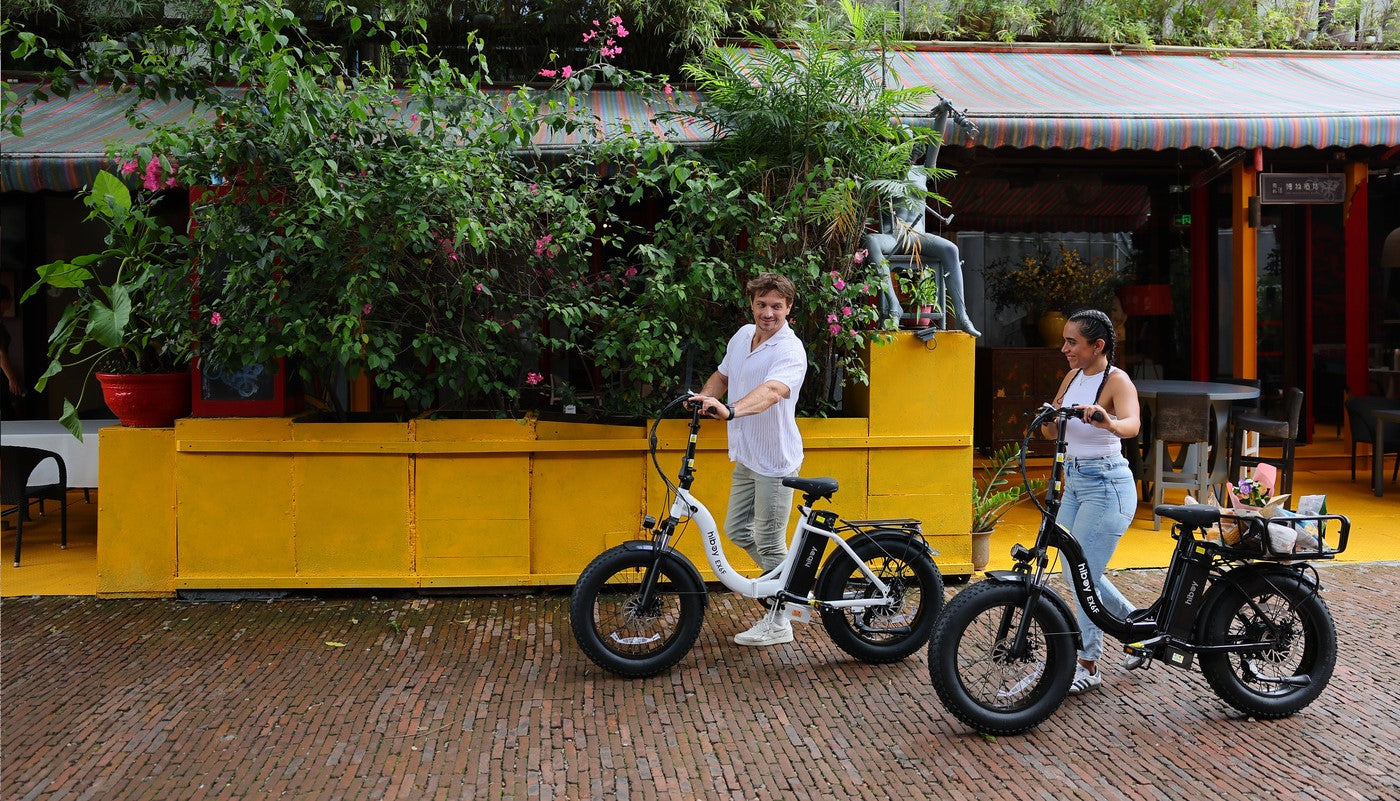Have you ever struggled to carry a full-sized bike up several flights of stairs, questioning your life choices? This scenario explains why folding eBikes are gaining popularity. They offer a blend of convenience and eco-friendly transportation, but are they worth the investment?
Urban cyclists navigating crowded city streets and limited storage space need practical solutions. Folding eBikes provide the portability and electric assistance that regular bikes can't match. However, these compact marvels come with trade-offs that may significantly impact your riding experience. The question isn't whether folding eBikes are good, but whether they're right for you.

Understanding Folding eBikes
What makes an eBike "foldable"
Folding eBikes are engineering marvels designed specifically for compactness and portability. They feature:
-
Carefully designed folding mechanisms, typically at the frame's center, handlebars, and pedals
-
Quick-release levers or clasps that allow collapsing the bike in under 30 seconds
-
Lightweight materials like aluminum alloys, with premium models using titanium or carbon fiber
-
Strategically placed batteries for balanced weight distribution when folded
Popular models in the market
The folding eBike market offers various options:
-
Brompton Electric: Renowned for its compact folding design
-
Tern Vektron: Known for stability and cargo capacity
-
Rad Power RadMini: Handles off-road conditions well
-
Lectric XP 2.0: Budget-friendly with impressive range and power
-
GoCycle G4: Sleek design with smartphone integration
Prices range from $1,000 to over $4,000, depending on components and build quality.
Key differences from standard eBikes
Folding eBikes trade some qualities for portability:
|
Feature |
Folding eBikes |
Standard eBikes |
|
Wheel size |
Typically 16-20" |
Usually 26-29" |
|
Frame rigidity |
Less rigid due to folding joints |
More solid construction |
|
Weight |
35-45 lbs (lighter) |
45-70 lbs (heavier) |
|
Range |
Generally shorter (20-40 miles) |
Often longer (30-80 miles) |
|
Top speed |
Usually 15-20 mph |
Can reach 20-28 mph |
Folding models feature more upright riding positions and shorter wheelbases, making them maneuverable in tight spaces but potentially less stable at high speeds.
Who benefits most from folding eBikes
Folding eBikes are ideal for:
-
Commuters using mixed transit
-
Apartment dwellers with limited storage
-
RV and boat enthusiasts
-
Office workers
-
Travel lovers
-
Those concerned about bike theft
They're perfect for urban dwellers with limited space who need efficient transportation for 2-10 mile trips.
Space-Saving Advantages

Compact storage solutions for apartment dwellers
Folding eBikes collapse to roughly half their size, easily fitting under desks, in closets, or behind furniture. Most models measure around 30"x25"x10" when folded, about the size of a medium suitcase.
Easy transportation in vehicles
Folding eBikes fit easily into car trunks without requiring disassembly or roof racks. Their quick fold-up design allows for hassle-free transportation.
Bringing your bike on public transit
Folding eBikes are transit-friendly and often allowed on systems that ban standard bikes. They're particularly useful for "last mile" solutions in multi-modal commuting.
Theft prevention through indoor storage
The ability to keep folding eBikes indoors provides peace of mind, especially considering their often high cost.
Workplace storage solutions
Folding eBikes can be stored under desks or in closets, avoiding workplace storage issues. Some commuters use discreet carrying bags to bypass "no bikes allowed" policies.
Portability Benefits
Multi-modal commuting possibilities
Folding eBikes allow for flexible transportation combinations, potentially cutting travel times significantly.
Travel and tourism applications
These bikes are perfect for exploring new cities, fitting easily into car trunks or even airline luggage (with battery removed).
Boat and RV compatibility
Folding eBikes are ideal for recreational vehicles and boats, where space is at a premium. They provide exploration options without untethering your entire setup.
Performance Considerations
Weight implications of folding mechanisms
Folding mechanisms add 2-5 pounds compared to non-folding models. The lightest folding eBikes typically weigh around 45 pounds.
Battery life and motor power
Folding eBikes usually have smaller batteries (250-400Wh) and less powerful motors (250-500W) compared to standard eBikes.
Ride stability compared to non-folding models
Smaller wheels and frame flex points can make folding eBikes less stable, especially at higher speeds.
Speed limitations
Folding eBikes typically max out at 15-20 mph, while standard models often reach 25-28 mph.
Practical Limitations
Folding/unfolding time requirements
Most folding mechanisms take 30 seconds to 2 minutes to operate, with premium models streamlining the process to 15-20 seconds.
Learning curve for new users
Mastering the folding sequence can take weeks, with more complex mechanisms requiring a steeper learning curve.
Weather resistance of hinges and joints
Folding points are vulnerable to water infiltration and dirt accumulation, requiring extra maintenance in wet climates.
Weight carrying capacity
Folding eBikes typically have lower weight limits (220-250 pounds) compared to standard eBikes (300+ pounds).
Financial Aspects
Price comparison with standard eBikes
Folding eBikes generally cost $300-500 more than comparable standard models.
Long-term maintenance costs
Folding eBike owners may spend 20-30% more on maintenance over five years compared to standard models.
Resale value considerations
Well-maintained folding eBikes often retain 50-60% of their value after three years, compared to 40-50% for standard models.
Insurance and security factors
Insurance premiums may be higher for folding eBikes, but indoor storage can reduce theft risk and potentially lower costs.
Return on investment for commuters
Urban commuters typically reach ROI within 10-14 months, compared to 15-18 months for standard eBike owners.
Durability Concerns
Stress points at folding mechanisms
Folding joints are potential weak spots, subject to wear and tear over time.
Longevity compared to traditional frames
Folding eBikes typically show their age around the 5-year mark, while well-made conventional eBikes might last 7-10 years.
Warranty considerations
Look for brands offering at least 2 years of coverage on the frame and folding mechanism.
Common repair issues
Frequent problems include loose mechanisms, cracked frames near stress points, broken latches, and electrical connection failures.
Folding eBikes offer significant advantages for urban dwellers and commuters, with their space-saving design and enhanced portability making them ideal for mixed-mode transportation and compact living situations. However, potential buyers should carefully weigh these benefits against practical limitations, including reduced performance, durability concerns, and higher costs. Your specific needs, storage constraints, and commuting patterns should ultimately guide your decision.
FAQs
-
Are folding eBikes significantly more expensive than standard eBikes, and do they hold their value well?
- This addresses the financial aspects, including the initial price comparison ($300-500 more than comparable standard models), maintenance costs (potentially 20-30% higher), and resale value (often retaining 50-60% after three years, which is better than standard eBikes).
-
What are the main performance differences between a folding eBike and a standard eBike, particularly in terms of speed, range, and ride stability?
- This covers the trade-offs mentioned, such as smaller wheel sizes (16-20" vs. 26-29"), generally shorter range (20-40 miles vs. 30-80 miles), lower top speeds (15-20 mph vs. 20-28 mph), and potentially less stability due to frame flex and smaller wheels.
-
How practical are folding eBikes for daily commuting, especially regarding folding time, carrying weight, and storage in small spaces or on public transport?
- This encompasses the core benefits and limitations: folding time (30 seconds to 2 minutes), weight (around 35-45 lbs), compact storage (fitting under desks or in closets), and ease of transport on public transit.
-
What are the durability concerns with folding eBikes, and what kind of maintenance should I expect compared to a regular eBike?
- This addresses issues like stress points at folding mechanisms, potential for loose mechanisms or cracked frames, weather resistance of joints, and the typical lifespan (around 5 years vs. 7-10 for conventional eBikes). It also touches upon warranty considerations.
-
Who would benefit most from choosing a folding eBike over a standard one, and what are the ideal use cases?
- This focuses on the target audience: commuters using mixed transit, apartment dwellers with limited storage, RV/boat enthusiasts, office workers, travelers, and those concerned about theft. It highlights suitability for urban dwellers needing efficient transport for shorter trips (2-10 miles).











Share:
Hiboy X300 vs. Max Pro: Find the Perfect Scooter for Your Ride Style
Step-Through vs Step-Over Which Frame Fits Your Needs